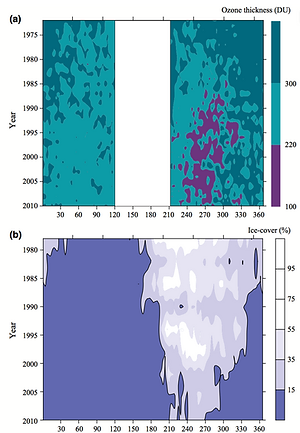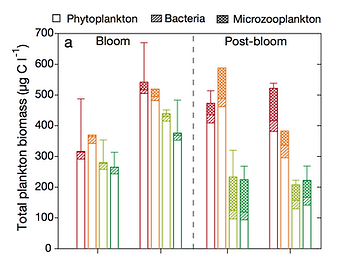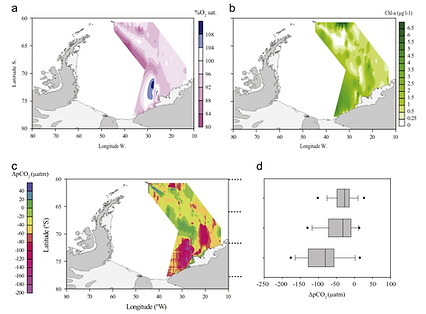 |  |  |  |  |
|---|---|---|---|---|
 |  |  |  |  |
 |  |  |  |  |
 |

Phytoplankton fate in the sea ice zone of the Southern Ocean
In the Southern Ocean, large-scale phytoplankton blooms occur in open water and the sea-ice zone (SIZ). These blooms have a range of fates including physical advection, downward carbon export, or grazing.
In this study, we determine the magnitude, timing and spatial trends of the biogeochemical (export) and ecological (foodwebs) fates of phytoplankton, based on seven BGC-Argo floats spanning three years across the SIZ. We calculate loss terms using the production of chlorophyll—based on nitrate depletion—compared with measured chlorophyll.
Export losses are estimated using conspicuous chlorophyll pulses at depth. By subtracting export losses, we calculate grazing-mediated losses. Herbivory accounts for ~90% of the annually-averaged losses (169 mg C m−2 d−1), and phytodetritus POC export comprises ~10%. Furthermore, export and grazing losses each exhibit distinctive seasonality captured by all floats spanning 60°S to 69°S. These similar trends reveal widespread patterns in phytoplankton fate throughout the Southern Ocean SIZ.
Fates of phytoplankton in the Southern Ocean (Moreau et al. 2020).
Calving Event Led to Changes in Phytoplankton Bloom
Phenology in the Mertz Polynya, Antarctica
Polynyas are the most productive areas in the Southern Ocean and play a role in the global oceanic circulation. Evaluating how unexpected and dramatic changes impact biology and chemical cycles in these areas is critical to understand the potential future impact such events may cause on a larger scale.
In this paper, we investigated the impact of the calving of a major glacier tongue in the Mertz polynya on the phytoplankton bloom using satellite data.
Significant changes happened after the calving event: (i) the bloom duration and open water period time decreased, (ii) the start of the bloom and the retreat of sea ice were delayed, and (iii) the chlorophyll‐a (the major phytoplankton pigment which indicates the phytoplankton biomass) and the sea ice concentration increased.
These findings show that natural changes can impact the timing of phytoplankton growth that may have consequences for the rest of the ecosystem, from Antarctic krill to baleen whales.

Change in bloom dynamics in the Mertz Polynya (Liniger et al. 2020).
The Biogeochemical Structure of Southern Ocean
Mesoscale Eddies
Mesoscale eddies are rotating bodies of water with diameters between 30 and 300 km that span weeks to months in the ocean. They are known to carry macronutrients (i.e., nitrate, silicate, and phosphate) across the Antarctic Circumpolar Current. Because of extremely limited direct observations of these eddies, it is difficult to calculate the actual quantity of nutrients that these eddies carry.
Here we present new observations of two cold‐core eddies that we sampled during austral summer and austral autumn in the Southern Ocean south of Tasmania.
We found that both eddies had similar nutrient distribution over their depth, especially below the mixed layer depth. Hence, this result motivated us to combine our observation with satellite observation to calculate the quantity of nutrients carried into the Subantarctic Zone by all the similar eddies. We found that eddies carried high‐nitrate and low‐silicate waters into the Subantarctic Zone. This transport has negligible impact on local biological production, but it has the capacity to change the nutrient content of waters that are exported from the Southern Ocean to lower latitudes.

Nutrients transport by mesoscale eddies (Patel et al. 2020).
Phytoplankton biomass in East Antarctic polynyas
In the Southern Ocean, coastal polynyas show high primary productivity and absorb large quantities of CO2. Three polynyas were visited in December-January 2017: the Dalton, Mertz and Ninnis polynyas.
In the Mertz and Ninnis polynyas, phytoplankton biomass and productivity were three times higher than those measured in the Dalton polynya. Phytoplankton communities also differed between the polynyas, with diatoms in the Mertz and Ninnis polynyas and flagellates in the Dalton polynya.
The higher productivity in the Mertz and Ninnis was caused by the relatively shallow inflow of iron-rich Antarctic deep water as well as by the large melting of sea ice. Our results show that physical drivers regulate the productivity of polynyas, suggesting that the response of biological productivity and carbon export to future change will vary.


Phytoplankton biomass in East Antarctic polynyas (Moreau et al. 2019).
Biogeochemistry of a Southern Ocean eddy
A large (~190 km diameter) eddy (a natural whirlpool), spinning clockwise, detached from the Subantarctic Front south of Tasmania in March 2016. We followed this eddy with satellites for 1 month before we sailed to it on-board the RV Investigator to study its physics, biology and chemistry.
Eddies are believed to pump nutrients from deep waters and enhance the growth of phytoplankton, the microscopic plants that thrive in the open ocean. Our eddy was, however, less productive than the ocean surrounding it.
Our observations led us to two hypotheses as to why phytoplankton was low in the eddy. 1) Phytoplankton need iron to grow and iron is a notoriously low in the Southern Ocean, so was it in the eddy. 2) Zooplankton eat phytoplankton and the high numbers of zooplankton observed in the eddy may explain the low biomass observed.
This eddy was, in fact, a very large source of CO2 for the atmosphere, and a large source of inorganic carbon to the Sub-Antarctic Zone.


Satellite-derived Chorophyll-a and delta-pCO2 between the ocean and the atmosphere (Moreau et al. 2017).
Climate Change impact on the Bellingshaussen Sea plankton
We looked at long term trends in climate change factors in the Bellingshaussen Sea: ozone layer thickness (1978-2010), sea ice cover (1978-2010) and sea surface temperature (1992-2010). Then, we evaluted the role of climate change on primary production modelled from satellite-derived ocean colour (1997-2010)
Sea ice cover decreased regularly since 1978, retreating in march in 1978 compared to October over the last decade, 2000-2010. The ozone hole forms every fall above Antarctica, from August to December, increasing the penetration of UVB radiation. Sea surface temperature also increased between 1990 to 2010.
As a consequences of these changes, the annual primary production of the Bellingshaussen Sea increased between 1997 and 2010 (from 0.73 to 1.03 Tg C yr-1). This is primarily explained by the increase in the length of the growing season.

Ozone thickness and sea ice cover (Moreau et al., 2015)
Winter to spring onset of the bloom in the Bellingshaussen Sea
Due to the extremely harsh conditions, there are very few winter data on Southern Ocean plankton. Winter sea ice conditions are very important drivers of the following summer primary production in the Bellingshaussen Sea: high sea ice extent and a late retreat favor strong spring primary production.
We studied the microbial community composition and production in the Melchior Archipelago (Bellingshaussen Sea) from May to December 2006. During winter and early spring, the community was mainly composed of heterotrophs (bacteria and microzooplankton) and small phytoplankton (picophytoplankton. After an early sea ice retreat, we did not observe the expected strong spring bloom.

Plankton biomass at the onset of the production season in the Bellingshaussen Sea
Role of sea surface temperature and UVBR on subantarctic plankton
Together with Ocean Acidification, the rise in sea surface temperature and UVB radiations are two fo the main serious threats for plankton (Hader et al.. 2007). A rise in sea surface temperature can have a positive effect on metabolic activities, but it can also modify the composition of planktonic communities, favouring small cells (ex. Montes-Hugo et al., 2009). And UVB radiations have many detrimental effects on plankton (ex. Ferreyra et al. 2006).
To understand the combined effects of rising sea surface temperature and UVB radiations, we conducted a mesocosm experiment in Patagonia. The rise in temperature changed the composition of the community from diatoms to prymnesiophytes and lowered the total plankton biomass. UVB radiations had little effect on the Patagonian community which may be already adapted to these high UVBR conditions.


T1
T2
T3
T4
Plankton biomass under experimental conditions
(CTRL, +UVBR, +T, +UVBR+T)
(Moreau et al., 2014, Thyssen et al. 2011, Moreau et al. 2015)
Role of Antarctic plankton on the biological pump
The Southern Ocean is one of the largest CO2 sink on Earth (Takahashi et al., 2009; Gruber et al., 2009). Within the Southern Ocean, coastal waters are among the most productive and important CO2 sinks.
As described above, climate change has a strong impact on the Bellingshaussen Sea physical conditions and on the composition of the planktonic community.
We looked at the role of the composition and metabolism of the planktonic community on the biological pump in the Bellingshaussen and the Weddell Seas between 2002 and 2005. We found that the phytoplankton compositon was a main driver of the sea surface pCO2 in the Bellingshaussen Sea but not in the Weddell Sea. In addition, the more coastal and soutern waters were larger CO2 sinks than offshore and north.

Sea surface O2 saturation, Chl-a concentration and delta-pCO2 in the Weddell Sea between 2002 and 2005